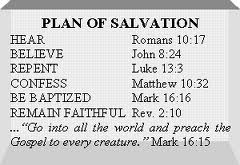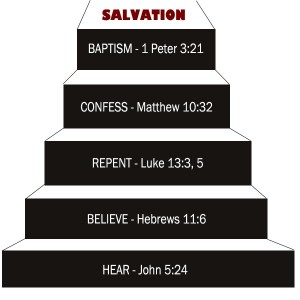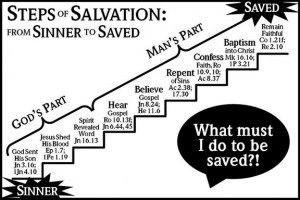It’s just a Church of Christ thing, right? The “Plan of Salvation,” also called the “Five Steps of Salvation,” is unique to us, I think. And those of us who were raised in and by the Churches of Christ know them well: Hear, Believe, Repent, Confess, Baptism. In that order. As a kid in the ’70s, this was drilled into me by my Sunday school teachers in Bible class, by the preachers from the pulpits, by the youth ministers at the devotionals and rallies, and by the Open Bible Study my dad walked me through when I reached the “age of accountability.” The five steps were plastered on bulletin boards in the church hallways, illustrated by charts and diagrams on mimeographed handouts, and splashed across banners promoting the next Gospel meeting. These were the five steps, always accompanied by supporting verses of Scripture, that necessarily had to be followed — again, in order! — for one to be saved.
Hear. Believe. Repent. Confess. Be Baptized.
You ever wonder how that started? You ever question the validity of such a list? If you or your church were to make a list of supposed steps to salvation, what would you include? What parts of our CofC list would you leave out?
 Historians point back to our movement’s focus on rational thought and enlightenment thinking that characterized the mainstream culture of America at the turn of the 19th century when Stone and Campbell and others were attempting to “restore” God’s Church. It was all about scientific reasoning and empirical evidence and deductive problem-solving. Society at this time was convinced that there were undeniable patterns, unalterable designs in nature and in the world that, if learned and applied, held the keys to everlasting peace and joy.
Historians point back to our movement’s focus on rational thought and enlightenment thinking that characterized the mainstream culture of America at the turn of the 19th century when Stone and Campbell and others were attempting to “restore” God’s Church. It was all about scientific reasoning and empirical evidence and deductive problem-solving. Society at this time was convinced that there were undeniable patterns, unalterable designs in nature and in the world that, if learned and applied, held the keys to everlasting peace and joy.
Alexander Campbell searched the Scriptures in this way and came up with what he called “the ancient gospel,” a pattern he believed was the divinely-ordained natural way to heaven. According to Campbell, it all boiled down to, in this order: gospel facts (death, burial, resurrection, and ascension of Christ), faith, repentance, reformation (of life), baptism, remission of sins, reception of the Holy Spirit, sanctification, resurrection of the saints, and eternal life. In that order. Campbell claimed that all Christian denominations believed in all these steps, but put them in different orders according to their own interpretations or theories of conversion.
At about the same time, Walter Scott came up with a biblical pattern and called it “the gospel restored.” He had six points originally. The first three were what humans had to do to be saved: believe, repent, and be baptized. The last three were what God promises to people who do the first three: forgiveness of sins, the gift of the Holy Spirit, and eternal life. Not too much later, Scott shortened his list to five points — one for each finger on a person’s hand, for easy remembering: faith, repentance, baptism, forgiveness of sin, and the gift of the Holy Spirit.
 This method proved to be very successful on the early American frontier where most everybody had been trained in Calvinism which claimed that men and women were saved only by God’s predestination, that one couldn’t do anything to save himself, it was all up to God’s pre-ordained choosing. By telling these fiercely independent early frontier people that there really was something they could do to be saved, the Stone and Campbell churches fueled a massive rush to repentance and baptism.
This method proved to be very successful on the early American frontier where most everybody had been trained in Calvinism which claimed that men and women were saved only by God’s predestination, that one couldn’t do anything to save himself, it was all up to God’s pre-ordained choosing. By telling these fiercely independent early frontier people that there really was something they could do to be saved, the Stone and Campbell churches fueled a massive rush to repentance and baptism.
As with most good things, we swung the pendulum a bit too far. Pretty soon, we were taking God’s initiative and the Holy Spirit’s active participation clear out of the conversion process. Preaching became all about proving “facts” with arguments and evidence. The Holy Spirit’s work in the past had been entered into the Biblical record and was there to be studied in a rational manner, but it wasn’t necessary for a person’s salvation. The emphasis was on logical fact-finding and step-following and persuading people to “obey the gospel.” The “gospel,” of course, being the steps. 
So, at some point in the middle of the 1800s, it gets boiled down to what we have today in the five steps of salvation or the plan of salvation: hear, believe, repent, confess, be baptized. Notice how God’s divine activity is completely absent from any of the steps. Notice how this chart here to the right — all of these charts were downloaded from Church of Christ websites this morning — actually gives much more responsibility or credit to man than to God for salvation. Where is God in our “plan of salvation?”
Why is baptism the last step? Who took out “sanctification,” the guiding of the Holy Spirit, and the grace of God to continually wash our sins?
It is God who works to will and to act according to his good purpose. It is God who initiates salvation, who begins the good work and sees it through to completion. Belief and repentance and confession are salvation steps to be taken every day, not once on a ladder list of human accomplishments. Baptism is never the end of what the apostle Paul calls “being saved,” it’s the beginning. Our five steps minimize our God. Our five steps neglect a lifetime of day-by-day, hour-by-hour difficult discipleship to Jesus. And they ignore the unmerited and continuous grace of our merciful Father.
OK, maybe that’s a little harsh. Too judgmental, probably, Yes, we come by the “five-steps” thing naturally. It’s been handed down to us by faithful men and women who were doing their very best with what they had to work with during the times they lived. And I’m grateful for it. Seriously. But I’m also so glad that we’ve recognized the many shortcomings in this kind of incomplete view of salvation. I’m so glad that we’re acknowledging together the active role of God’s Spirit in the calling and saving and sanctifying of the saints. And I’m glad we can change. I’m so glad, by God’s grace, we’re allowed and even compelled to change.
Peace,
Allan

What will the Paper Pulpit have to say about this?
Crazy how we talked about that at lunch today, and I didn’t even know you had blogged about that! Great meeting another Delta member and I had a blast today getting to know you!!
Thank goodness, I haven’t commented in ages, AMEN. May we never cease to be thankful that God is completing the work he began in us daily, until finally the Lord returns.
Oh MY! Does this mean that scripture is revelatory – not regulatory?
LOVE this post.
“It is God who initiates salvation, who begins the good work and sees it through to completion. Belief and repentance and confession are salvation steps to be taken every day, not once on a ladder list of human accomplishments.”
That statement is what I grew up believing, and ever since I left my home church I have been feeling like a lot of other people forget that God is the biggest one acting during baptism.
I have to ask these questions: Why did God not list the 5 steps of salvation in any one place? Did he really want us to have to search the scriptures and pull these items out as being the most important? Why different people were told different things when asking about their salvation? Could it be God is the one that determines the moment of salvation and not us? Thank you for your comments.
Ummm… because there aren’t five steps of salvation. I believe by the power of God’s Spirit we take steps of salvation every hour of every day. Baptism, as the act of trust in and submission to Jesus as Lord, is the first step, not the last.
Love, love, love this!!! I’m in my 60s, was born and raised in “the church” and have fought against the Holy Formula for years. I stumbled across your blogsite and just wanted to thank you! Do you mind if I link this article to a discussion board? You might get some not-so-happy responses, if I do. (CARM is the name of the forum.)
Do with this what you will, Linda. Just remember that we’re not “fighting” against anything. We are learning and growing, stretching and moving; we are “being saved” together.
I was raised in the baptist belief along with many others. At the age of 18 i had a bible class with a brother from the church of Christ on the Plan of salvation. I was taken from the book of Genesis to Revelation. Emphasis was put on the gospels and the book of act I guess because they stress the gospel and the plan of salvation. Upon completing my study, I found what had been missing from committing to a true christian. I had always known that something was wrong with praying on the morning bench. I knew there was a simpler method on becoming a christian. That study lead me to accept Christ according to the bible. I completed the five steps and have been a christian for the past 47 years. Yes baptism is essential to salvation as confessing and repenting, believing and hearing.
This message need to reach all church of Christ ministers
this five step salvation plan is a false teaching, it is not the Gospel. This is man gospel, and not God’s. Eph.2:8-10, Rom.10:9-10. is more like the true Gospel. Can you help me get this out to all church of Christ ministers, and Also let them know that the church can not save you, and that we are a saved church because of Christ, and not the church.
Obie,
The verses that you write about, speak of Grace. The word Grace, “means unmerited favor.” The unmerited favor in this particular case is that God sent his only son so that we could receive forgiveness of our sins.
In Acts 2:38 we are told what must be done. This is the start on the way to salvation.